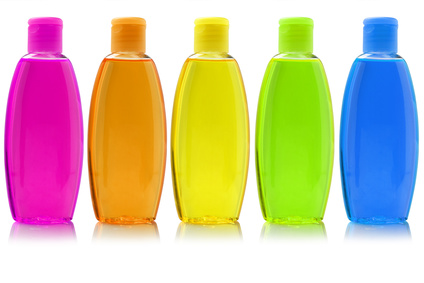Eine Shampoo-Flasche die sich bis auf den letzten Tropfen leeren lässt

Forscher der Ohio State University haben Kunststoff-Oberflächen mit Silicium-Nanopartikeln behandelt, so dass Shampoo an diesen nicht haften bleibt. Dies ist nicht nur für den Kunden von Vorteil, der so auch den letzten Tropfen Shampoo einfach aus der Flasche bringt, sondern auch für das Recycling. Denn bevor Plastikflaschen recycelt werden können, müssen diese heutzutage in einem aufwendigen Verfahren gereinigt werden.
It’s one of life’s little annoyances: that last bit of shampoo that won’t quite pour out of the bottle. Or the last bit of hand soap, or dish soap, or laundry detergent. Now researchers at The Ohio State University have found a way to create the perfect texture inside plastic bottles to let soap products flow freely.
The technique involves lining a plastic bottle with microscopic y-shaped structures that cradle the droplets of soap aloft above tiny air pockets, so that the soap never actually touches the inside of the bottle. The “y” structures are built up using much smaller nanoparticles made of silica, or quartz—an ingredient in glass—which, when treated further, won’t stick to soap.
It’s what you’d call a first-world problem, right? ‘I can’t get all of the shampoo to come out of the bottle.’ But manufacturers are really interested in this, because they make billions of bottles that end up in the garbage with product still in them. Coatings already exist to help food, but not soap, pour out of their containers. Compared to soaps, getting ketchup out of a bottle is trivial. Our coating repels liquids in general, but getting it to repel soap was the hard part.
The key is surface tension—the tendency of the molecules of a substance to stick to each other. Ketchup and other sauces are made mostly of water, and water molecules tend to stick to each other more than they stick to plastic. But surfactants—the organic molecules that make soap “soapy”—are just the opposite: They have a very low surface tension and stick to plastic easily.
The Ohio State invention could actually aid recycling. Before plastic bottles can be recycled, they have to be rinsed completely clean.
With further development, the university hopes to license the coating technique to manufacturers—not just for shampoo bottles, but for other plastic products that have to stay clean, such as biomedical devices or catheters. They have already applied the same technique to polycarbonate, a plastic used in car headlights and smartphone cases, among other applications.
Quelle: Ohio State University
Bildquelle: Fotolia